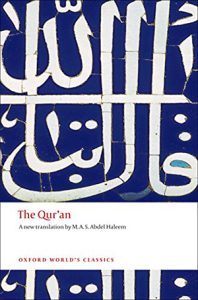The Qur'an: A New Translation

One of the most influential books in the history of literature, recognized as the greatest literary masterpiece in Arabic, the Qur’an is the supreme authority and living source of all Islamic teaching, the sacred text that sets out the creed, rituals, ethics, and laws of Islam. Yet despite the growing interest in Islamic teachings and culture, there has never been a truly satisfactory English translation of the Qur’an, until now.
This superb new translation of the Qur’an is written in contemporary language that remains faithful to the meaning and spirit of the original, making the text crystal clear while retaining all of this great work’s eloquence. The translation is accurate and completely free from the archaisms, incoherence, and alien structures that mark existing translations. Thus, for the first time, English speaking readers will have a text of the Qur’an which is easy to use and comprehensible.
Furthermore, Haleem includes notes that explain geographical, historical, and personal allusions as well as an index in which Qur’anic material is arranged into topics for easy reference. His introduction traces the history of the Qur’an, examines its structure and stylistic features, and considers issues related to militancy, intolerance, and the subjection of women.
Clearly written and filled with helpful information and guidance, this brilliant translation of the Qur’an is the best available introduction to the faith of Moslems around the world.
Table of Contents
Introduction
- The Life of Muhammad and the Historical Background
- The Revelation of the Qur’an
- The Compilation of the Qur’an
- The Structure of the Qur’an: Suras and Ayas
- Stylistic Features
- Issues of Interpretation
- A Short History of English Translations
- This Translation
A Chronology of the Qur’an
Select Bibliography
Map of Arabia at the Time of the Revelation
The Qur’an
1. Al-Fatiha (The Opening) / 2. Al-Baqara (The Cow) / 3. Al-‘Imran (The Family of ‘Imran) / 4. An-Nisa (Women) / 5. Al-Ma’ida (The Feast) / 6. Al-An’am (Livestock) / 7. Al-A’raf (The Heights) / 8. Al-Anfal (Battle Gains) / 9. At-Tawba (Repentance) / 10. Yunus (Jonah) /
11. Hud / 12. Yusuf (Joseph) / 13. Ar-Ra’d (Thunder) / 14. Ibrahim (Abraham) / 15. Al-Hijr (Al-Hijr) / 16. An-Nahl (The Bee) / 17. Al Isra’ (The Night Journey) / 18. Al-Kahf (The Cave) / 19. Maryam (Mary) / 20. Ta Ha /
21. Al-Anbiya (The Prophets) / 22. Al-Hajj (The Pilgrimage) / 23. Al-Mu’minun (The Believers) / 24. Al-Nur (Light) / 25. Al-Furqan (The Differentiator) / 26. Al-Shu’ara’ (The Poets) / 27. Al-Naml (The Ants) / 28. Al-Qasas (The Story) / 29. Al-Ankabut (The Spider) / 30. Al-Rum (The Byzantines) /
31. Luqman / 32. As-Sajda (Bowing Down in Worship) / 33. Al-Ahzab (The Joint Forces) / 34. Saba’ (Sheba) / 35. Fatir (The Creator) / 36. Ya Sin / 37. As-Saffat (Ranged in Rows) / 38. Saad / 39. Al-Zumar (The Throngs) / 40. Ghafir (The Forgiver) /
41. Fussilat ([Verses] Made Clear) / 42. Al-Shura (Consultation) / 43. Al-Zukhruf (Ornaments of Gold) / 44. Al-Dukhan (Smoke) / 45. Al-Jathiya (Kneeling) / 46. Al-Ahqaf (The Sand Dunes) / 47. Muhammad / 48. Al-Fath (Triumph) / 49. Al-Hujurat (The Private Rooms) / 50. Qaaf /
51. Al-Dhariyat (Scattering [Winds]) / 52. Al-Tur (The Mountain) / 53. Al-Najm (The Star) / 54. Al-Qamar (The Moon) / 55. Al-Rahman (The Lord of Mercy) / 56. Al-Waqi’a (That which is Coming) / 57. Al-Hadid (Iron) / 58. Al-Mujadala (The Dispute) / 59. Al-Hashr (The Gathering [of Forces]) / 60. Al-Mumtahana (The Woman Tested) /
61. Al-Saff (Solid Lines) / 62. Al-Jumu’a (The Day of Congregation) / 63. Al-Munafiqun (The Hypocrites) / 64. Al-Taghabun (Mutual Neglect) / 65. Al-Talaq (Divorce) / 66. Al-Tahrim (Prohibition) / 67. Al-Mulk (Control) / 68. Al-Qalam (The Pen) / 69. Al-Haqqa (The Inevitable Hour) / 70. Al-Ma’arij (The Ways of Ascent) /
71. Nuh (Noah) / 72. Al-Jinn (The Jinn) / 73. Al-Muzzammil (Enfolded) / 74. Al-Muddathir (Wrapped in his Cloak) / 75. Al-Qiyama (The Resurrection) / 76. Al-Insan (Man) / 77. Al-Mursalat ([Winds] Sent Forth) / 78. Al-Naba’ (The Announcement) / 79. Al-Nazi’at (The Forceful Chargers) / 80. ‘Abasa (He Frowned) /
81. Al-Takwir (The Rolling Up) / 82. Al-Infitar (The Breaking) / 83. Al-Mutaffifin (Those who Give Short Measure) / 84. Al-Inshiqaq (The Cracking) / 85. Al-Buruj (The Toweing Constellations) / 86. Al-Tariq (The Night-Comer) / 87. Al-‘Ala (The Most High) / 88. Al-Ghashiya (The Overwhelming Event) / 89. Al-Fajr (The Daybreak) / 90. Al-Balad (The City) /
91. Al-Shams (The Sun) / 92. Al-Layl (The Night) / 93. Al-Duha (The Morning Brightness) / 94. Al-Sharh (Relief) / 95. Al-Tin (The Fig) / 96. Al-‘Alaq (The Clinging Form) / 97. Al-Qadr (The Night of Glory) / 98. Al-Bayyina (The Clear Evidence) / 99. Al-Zalzala (The Earthquake) / 100. Al-‘Adiyat (The Charging Steeds) /
101. Al-Qari’a (The Crashing Blow) / 102. Al-Takathur (Competing for More) / 103. Al-‘Asr (The Fading Day) / 104. Al-Humaza (The Backbiter) / 105. Al-Fil (The Elephant) / 106. Quraysh / 107. Al-Ma’un (The Common Kindnesses) / 108. Al-Kawthar (Abundance) / 109. Al-Kafirun (The Disbelievers) / 110. Al-Nasr (Help) /
111. Al-Masad (Palm Fibre) / 112. Al-Ikhlas (Purity of Faith) / 113. Al-Falaq (Daybreak) / 114. Al-Nas (People)
Index

M. A. S. Abdel Haleem is the King Fahd Professor of Islamic Studies and director of the Centre for Islamic Studies at the School of Oriental and African Studies (SOAS) of London University, as well as editor of the Journal of Qur’anic Studies. Born in Egypt, he learned the Qur’an by heart during childhood. Haleem has published two translations of the Qur’an: The Qur’an: English Translation with Parallel Arabic Text (2010) and The Qur’an: A New Translation (2004). He has also published several other works in this field, including Understanding the Qur’an: Themes and Style (2001) and, together with Elsaid M. Badawi, Arabic-English Dictionary of Qur’anic Usage (2008).
Source: https://berkleycenter.georgetown.edu/people/muhammad-a-s-abdel-haleem
More from M. A. S. Abdel Haleem in this library, click here.
